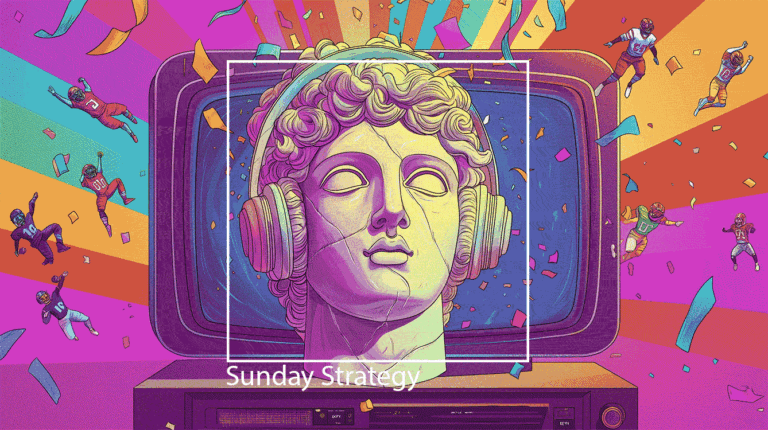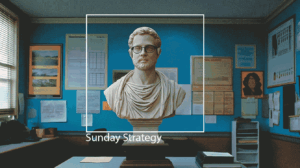Volume 2: Issue 6 // February 9th, 2025
In this issue of Super Bowl day issue of Sunday Strategy, we look at five stories to think about next week, including: Super Bowl Attention, a Winning Big Game Ad, Anti-Humanizing Technology, Status Symbol Relationships and Capri Sun’s Shift.
In addition, we have ads from: Mountain Dew, Squarespace, Google, Verizon and the Ordinary.
// Five Stories of the Week:
1.) The Game Outside of the Game for Super Bowl Advertisers
Looking at the coverage of this year’s Super Bowl ads, you would be tempted to say there’s a renaissance in comms planning. Faced with an estimated $8m cost for a spot in the big game, brands have become innovative in how they approach the media of the game, not just what they do creatively to capture attention.
From E.L.F’s ‘The E.L.F. Time Show’, to Google (which made and placed 50 ads in each state) and Zeam’s local media focused approach, Angel Soft asking people to turn their ad into a bathroom break (no pressure), Twix creating a staring contest for gold bars or Fetch giving away $10k a second during the final two minutes – brands are competing for attention beyond the TV spot. Even Nike is returning to the game after 27 years. With so many different approaches to capturing attention, it’s hard to say what comes out on top. However, while the Super Bowl is a unique moment, if brands so aggressively and innovatively fought for and considered attention in other moments throughout the year – advertising would be the real winner.
**** Worried that watching the Super Bowl for the ads isn’t enough? Play Super Bowl Ad Bingo and see how quickly this year’s ads hit all the expected cameos and tropes ****
2.) What’s the Formula for a Super Bowl Ad?
Is there a format for a winning Super Bowl ad? It’s less clear than predicting whether Taylor Swift will join Kendrick Lamar at halftime. Trying to create a formula for advertising success has to take into account changing cultural tastes (with this year’s ads skewing more apolitical and culturally agnostic after the US election), expanding media and comms platforms and an increasingly expensive landscape. With all of this to consider, the best we can hope for is to strategically classify the different entries to the big game – which both Shots and Fast Company do in an interesting way. Probably less risky than trying to predict a ‘winner’ before the game!
3.) Supporting Humanity, Not Humanizing Technology Brands
OpenAI has rebranded in a typography-led effort that aims to confer an emotional element to the brand and technology behind it. While technology is constantly in search of a greater emotional hook, OpenAI’s effort is unique in what they’ve left out. No where in the coverage is a mention of ‘humanizing’ the brand, a common refrain when it comes to technology and artificial intelligence. Instead, OpenAI speaks to serving humanity, keeping its tech friendly but distinct from the human beings that use it. The shift may speak to a greater insight into what we want to AI, not a virtual version of humanity but something that helps us find more humanity in ourselves.
4.) Are Relationships Becoming a Status Symbol?
Amongst the coverage of a ‘Relationship Recession’ around the globe or a shortage of men that are ‘Marriage Material’, the economic distribution of relationships is often lost in the noise. While money is undeniably at the heart of the shifting nature of young people and relationships, children and marriage – the disproportionate change in relationships amongst less affluent individuals is worth considering.
Are we on the cusp of marriage, children and traditional relationships becoming a subtle flex? Are we at risk of those who can’t afford a relationship being sold something as a substitute? The risk of, as the IPPR called it in a new report ‘Addictive Intelligence’ from AI companions shows where we could go.
5.) Without a Pouch, Is Capri Sun Just Another Beverage?
The elements of a product that make magic don’t always make sense. But when you have one, you should be really careful about moving away from it. The news that Capri Sun, famous amongst American children and those who used to be ones, has added a bottle format alongside its well known pouch is a bit surprising. Like San Pellegrino’s foil tops, Capri Sun’s pouch is an integral part of the brand.
The bottle shift is reportedly coming from a need to get greater retail placement and distribution, but without the pouch (and the latent risk of jamming a straw all the way through it) is it even the same brand? The bottle may get the brand in newer places, but what gets it chosen in those placements?
// Ads You Might Have Missed:
1.) ‘Kiss from a Lime’ – Mountain Dew:
Mountain Dew’s 2025 Super Bowl ad that combines a glut of 90s / 2000s nostalgia with an art direction that seems straight from a ‘Three Wolves’ novelty t-shirt. Promoting the official song of their ‘Baja Blast’ product, it features Becky G and Seal in a very literal casting, as a seal singing the undeniable 90s jam ‘Kiss from a Rose’. While the ad itself calls out that ‘none of this makes any sense’, it doesn’t have to – cramming enough cultural callbacks in together with product references to get the brand talked about in viewing parties around the nation, even if it isn’t understood.
2.) ‘A Tale as Old as Websites’ – Squarespace:
Squarespace’s 2025 Super Bowl ad features actor Barry Keoghan as a delivery man for websites, throwing them towards Irish cottage businesses and pubs in the style of a paper boy. Aside from getting the brand’s name in the ad frequently, it also highlights different types of businesses quickly – but leaves open a question on whether this clever ad brings too much nuance for viewing audiences.
Both Squarespace and GoDaddy are advertising this year and both have brought ads which tell wildly different stories about websites and business – with GoDaddy using actor Walton Goggins to launch the parody ‘Walton Goggins Goggle Glasses’ product. With a frantic battle for attention throughout the game, whether clever narrative humor or hyperbolic product wins out in creating awareness and distinction for one of the two brands has yet to be seen.
3.) ‘Dream Job’ – Google:
Google’s Super Bowl ad takes a nuanced view to how its Gemini AI can fit into the lives of people. While AI missteps have shown users outsourcing their humanity to AI (to famously write letters for kids or summarize things they couldn’t be bothered to read), the ad shows how technology can enhance our potential to be our best selves – showing the story of a stay at home Dad re-entering the job market after his child leaves for college.
4.) ‘Conquering Dead Zones’ – Verizon:
US telecommunications brand Verizon has combined advertising nostalgia and a real life astronaut to promote its new satellite based connectivity. The technology, which eliminates ‘dead zones’ in coverage and allows users to text via satellite, is promoted by Dr. Buzz Aldrin in a series of locations where he asks ‘Can you text me now’ – harkening back to the brand’s classic ‘Can your hear me now?’ campaigns. To fully link to these, the original spokesman is featured, showing how coverage ads, which often resort to maps and dots, can be more engaging and pay back to the heritage of a brand.

5.) ‘The Wikileaks of Beauty’ – The Ordinary:
Skincare brand, the Ordinary, has set out to disrupt the beauty market, publishing a set of whitepapers taking aim at the common misconceptions and beliefs held by consumers. Under the banner of ‘The Wikileaks of Beauty’, the brand has packaged up their research in a compelling, simple and easily accessible website. Whereas the truth in sectors like beauty is often hidden behind detail and science, The Ordinary has shown how brand values like transparency and simplicity can be sharpened to fix industry issues and not just guide brand identity and experience.
// Sunday Snippets
// Marketing & Advertising //
// WARC’s excellent ‘The Multiplier Effect’ makes a compelling case for the value of brand and its interplay with performance [Research]
// Running brand ‘On’ taps Roger Federer and Sesame Street’s ‘Elmo’ to debate the nature of their logo in their Super Bowl ad [Ads]
// Glen Powell takes on ‘Goldilocks and the Three Bears’ in his own way for Dodge Ram’s Super Bowl Ad [Ads]
// US water brand Liquid Death has announced an exit from international markets after slower sales and production shifts [Marketing]
// Wilson’s air-less 3D printed basketball is back, for another limited run [Products]
// IKEA and dating app Breeze are partnering to offer in-store Valentines dates [Ads]
// Starbucks reintroduces itself in a new ad ‘Hello again’ [Ads]
// KFC borrows a page from London’s famous Polo Bar, highlighting how its 24/7 by removing the doors from its locations and turning them into ads [Ads]
// DDB has doubled down on emotional response to advertising with their new ‘Feels Barometer’ [Research]
// Browser company Opera is offering people a chance to visit a ‘Hygge desk’ to decompress [Ads]
// After decades away, McDonalds US is bringing back O’Grimacy, Grimace’s Irish relative. No word on Cookie O’Puss’ reaction at Carvel. [Food]
// Technology & Media //
// Apple launch an invite app, allowing Apple Plus users to invite others to events with custom invitations [Technology]
// Pinterest have released their 2025 cultural moments calendar [Culture]
// The value of Donald Trump’s $Trump meme-coin has dropped 75% in value since the US inauguration [Crypto]
// As US user’s dalliance with new Chinese social media apps highlighted, the focal points of Western (media) and Chinese (commerce) social apps is still far apart [Social Media]
// The rise and growth of ‘AI Native’ Companies [AI]
// Apple ordered to create UK backdoor for encryption, sparking looming privacy fight [Privacy]
// McKinsey breaks down the different roles for AI in strategic development [AI]
// AI company Anthropic ironically asks applicants not to use AI in their job application [AI]
// Do Yondr pouches really work to keep mobile phone usage down in schools? [Technology]
// Life & Culture //
// The IPA’s 2024 Agency Census shows growing gender and ethnicity pay gaps, as well as pervasive ageism [Work]
// 40% of US workers would take at least a 5% pay-cut to keep working from home and 9% would take a 20% cut [Work]
// The trailer for Fantastic Four first steps has dropped in advance of its summer release date, featuring a 60s aesthetic and hinting at Wandavision-esque filming styles [Film]
// If you really want to ‘get’ British culture, the New York Times thinks you should stay in a pub. They’re clearly heavy sleepers [Culture]
// Football Manager’s 2025 installment has been cancelled after two delays [Gaming]
// Is a Bridget Jones’ return driving an increase in Chardonnay? [Food]
// Until Next Sunday
As always, let me know what you think by email (dubosecole@gmail.com), website or on LinkedIn.
You can also listen to an audio summary and discussion of each week’s newsletter on Spotify. We’re also on TikTok!



